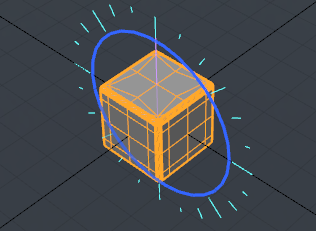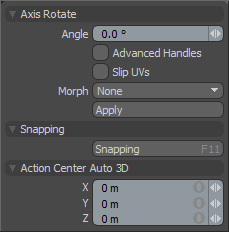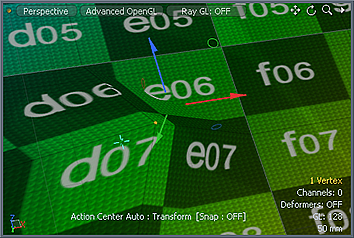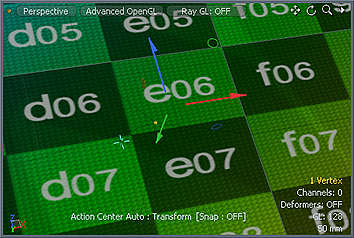
The Axis Rotate tool obviously allows users to rotate a selection by a specific number of degrees. The Axis Rotation tool is different from the standard Rotate tool in that it is limited to editing a single axis at a time, determined by the Work Plane position. It also has a different on-screen control display than the other transform tools providing a greater degree of control over the amount of rotation depending on how long or short the user drags out the handle length. Holding the 'Ctrl' key will constrain the rotation to fixed 15° intervals. After applying a transform amount, users may press the MMB to re-apply the previous offset amount, making it easy to apply an edit multiple times. The command can be activated in the 'Basic' subtab of the Modeling viewports, users may need to press the 'Shift' key to show alternate tool. User may also activate the tool from the menu bar under 'Edit >Transform > Axis Rotate' or by pressing the 'Alt+Shift+E' keyboard shortcut.
In the component modes, 'Vertices', 'Edges', and 'Polygons', the tool affects the selected geometry directly; when nothing is selected, it affects all active foreground geometry. Active foreground items are those that are visible and selected (highlighted) in the 'Item List'. In 'Items' mode the tool affects all the currently selected items in the Item List, if nothing is selected, then the tools will appear to do nothing. In material mode, it works the same way as in any of the component modes. Lastly, in the 'Center and 'Pivot' modes it modifies the Center or Pivots respectively. Note that users will need to physically select either the Center or the Pivot itself, depending on the mode, prior to activating the tool, as in Items mode, with no selection the tool will appear to do nothing.
When users define any of the various Falloffs MODO provides, application of the tool can be attenuated across a user defined area. For more on using Falloffs, please reference the Selection Falloffs page of the documentation.
Once the tool becomes active, MODO draws the relevant tool handle within the viewport. At this point, users may simply click and haul anywhere inside the desired viewport to interactively rotate the geometry, depending on the action center, this may also set the rotation center based on the mouse click position intersecting the Work Plane. Additionally, users may prefer to utilize the on screen display, either clicking on the wheel to rotate to a specific amount, or by dragging the handles on the value bar across the top of the viewport (when 'Advanced Handles' is enabled). When clicking on the wheel, a handle is drawn displaying the number of degrees. When using this handle the rotation sensitivity is adjusted based on the distance the mouse is from the handles as you drag. This can be thought of as extending a lever. The longer the lever, the more mouse movement is required to rotate the element and thus the granularity of control is increased. To interactively scale the size of the handles themselves, users may use the ' - ' and ' = ' keys on the keyboard to adjust them; minus makes them smaller, while equals makes them larger.
The Rotate tool also respect the settings for 'Action Center', and will originate the action from the defined position. For more information on understanding and using Actions Centers, please reference the Action Center page of the documentation.
 Axis Rotate--
Axis Rotate--
Angle: Users may use the 'Angle' input field to apply specific rotational value, calculated in degrees. When adjusting an object interactively in the viewport, the 'Angle' input fields will display the current rotation amount, providing useful user feedback.
Advanced Handles: Determines whether or not MODO displays the additional information and controls in the viewport.
Slip UVs: (Only in Component Modes) UV values are generally fixed to specific vertices, subsequently further edits to the geometry may warp, deform or otherwise distort the UV values in undesirable ways requiring users to adjust the map or redo it altogether. To avoid this undesirable result, users can enable the 'Slip UVs' function so as to not disturb any existing UV mapping applied to the geometry.
 'Slip UVs' function disabled, note texture warping. |  'Slip UVs' function enabled, texture remains even. |
Morph: (Only in Component Modes) The Morph option determines how MODO treats stored Morph information when applying transforms to geometry (Move, Rotate, Scale, etc.). In previous versions of MODO, in order to transform a Morph along with its base, it needed to be selected in the Vertex Map list. If it wasn't, relative Morph map data when recalled would produce distorted, undesirable results. If users were unaware of the requirements, it was easy to accidentally mess up a model. To remedy this problem, there are now three options controlling how the Morph Map vertex data is dealt with when applying any transforms--
None- Unselected Morph data is not affected, though selected (visible) Morphs can still be transformed independent of their source.
Transform- With this option selected, Morph data is transformed along with base mesh.
Keep Positions- With this option Selected, Morph data is converted into a Absolute Morph Map and all vertices retain their pre-transformed positions.
Child Compensate: (Only in Items Mode) The 'Child Compensate' toggle when disabled will pass along the transform value to any child items of the current selection, when enabled, the child items will ignore any transform values.


